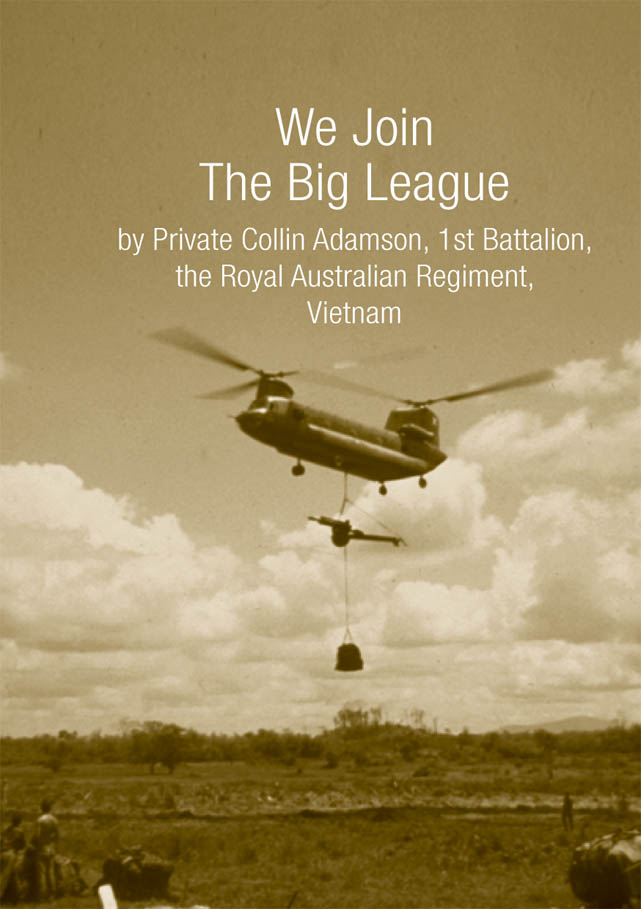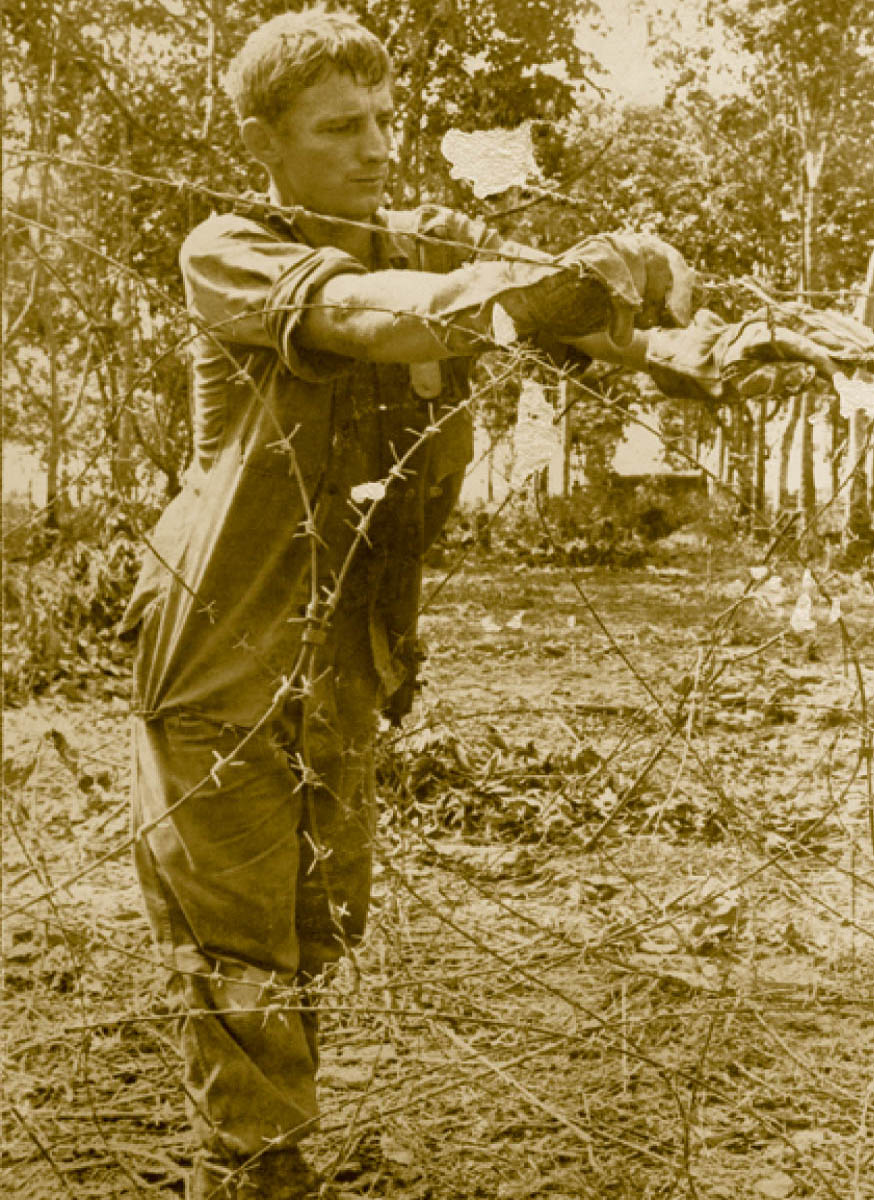

It was May 1968 and 1st Battalion, the Royal Australian Regiment, in which I commanded A Coy, was ordered into War Zone D some 50 kilometres north east of Saigon. We were to take up ambush positions and pick off the retreating North Vietnamese Army (NVA) and Viet Cong (VC) forces that were streaming northwards out of Saigon, cold, wet, tired and hungry. The heli-lift was to put us into Fire Support Base Coral and from there A, B and D Companies were to move north to establish the ambushes. Battalion HQ was to join me later and C Coy was to clear the road south to Tan Yuen.
Our fly-in was delayed for hours, because unknown to us at the time, US 1st Division was engaged in a massive fire-fight west of Fire Support Base Coral. We were held up until close to last light on 12th May. There were other complications too: we had landed at the wrong spot, the 3rd Battalions (3RAR) security was out of position and Battalion HQ had decided to stay with the guns and mortars for the night.
So off we set. I recall we had gone about 1,500 metres roughly north, with D Coy well to our west and B Coy off to our east. And then they struck! Between 0200hrs and 0300hrs the next morning the sky was alight with flares and green tracer accompanied by sundry loud noises from mortars, rockets and bugles. The battalion radio net was alive and with a lot of traffic by the mortars and D Coy. The artillery radio net was calling for fire. Spooky was up there and gunships were joining in as well. B Coy was taking fire; D Coy was under rocket propelled grenade attack and accepting casualties; the mortars were being overrun; the guns were firing over open sights and fighting hand to hand; the anti-tank platoon was firing splintex and the tracker dogs were cowering in their pits.
Sitting fat and happy, my company was unnoticed as the NVA tried to slip around us. We inflicted an unknown number of casualties on them. They did not stay to continue the argument. Early in the morning we were all directed to return to Fire Support Base Coral.
No sooner had my company commenced to move than we started taking over from D Coy as it went in with the bayonet on the entrenched enemy. We were stinking hot, hugging the dirt and praying that it would all soon be over.
Fortunately, Mal Meadow’s 1 Platoon was leading and managed to shake itself loose. I directed Mal to continue at best speed, search out the Operations Officer for instructions and be ready to guide us in. Too late! By the time we arrived, B Coy had settled down to a nice and tidy closed up defensive position which forced me into a stretched out three up nightmare with company headquarters providing depth and my support section of three preparing for the counter-attack role! The platoons themselves, of course, were three sections up with their headquarters also providing depth! Far to my left was C Coy. Its right flank up on a small ridge could look down on me from 400 metres away in the shade of rubber trees.
Taking my signaler, Bluey McIntyre, I went over to say hello, pointed out my positions and arranged for a couple of machineguns to be placed on fixed lines to cover the gap.
On the way back I dropped in on a troop of armoured personnel carriers stuck behind bunds and sorted out the gap with them as well. Finally I had my Mortar Fire Controller take a look at it for future reference. In the meantime, Bob Sutton, the Officer Commanding 2 Platoon, had taken out a standing patrol to our front and a load of star pickets and wire had arrived.
It was a pitifully small amount, but we did the best we could by stretching it pretty tight. Neil’s 3 Platoon, for example, had a single roll of concertina wire to cover his entire front. Digging into soft and sandy loam was a continuing task with interruptions as Charlie probed for our boundaries and defences. One of my machineguns finished off a fellow who was up a tree some 300 metres to the north.
As dark came, the standing patrols came in and we stood to. My command post was dug; but without overhead protection. We attempted to make it lightproof with ponchos. Radio traffic was fairly heavy but there was nothing of much importance and by 2200hrs I decided to give it away.
The radio watch roster was set and instructions given. My hole was a few metres away. Sleep did not come easy as my mind was alive with questions I could not answer. I was sure that Charlie would come again. I had already discussed this with Colonel Bennett and sensed he agreed. There was just too much activity out there for it to be otherwise. As it turned out, we had a respite that night and spent the 14th strengthening our defences somewhat and continuing with our standing patrols.
Stand to that night brought about further problems. Shorty Thirkle and Frank Maton were both struck down by heavy calibre machinegun fire. This meant that Neil’s 7 Section on the vital flank next to the gap was without its two non commissioned officers.
The 15th passed without major incident. Once again, a pitiful amount of defence stores arrived and was quickly used up. Our standing patrols kept Charlie at arms length. He hadn’t forgotten us of course. We were sitting across his main supply route and his only choices were to go around us and have us in his rear, or to dislodge us completely. Logic told me that we would see him in some force.
About 0200hrs on the 16th he came, with satchel charges and Bangalore torpedoes blowing my wire. Mortars and rocket propelled grenades were falling heavily onto Neil’s left-hand section and causing further casualties. I was on my feet and ran for the command post. I tripped over a roll of dannert, got up but was knocked flat again by a nearby explosion. There was nothing big about it, but 25 years later pieces of metal were still coming out of my back. The situation was becoming quite serious. Only a couple of Neil’s section was still standing and I told him to withdraw them. Of course this left the gap even wider. By this time, Charlie was also visiting the whole of my front and spilling over to B Coy. Our mortars and the cavalry troop began to put fire into the gap and the guns were dropping rounds into the area of the likely forming up points. My machineguns were covering the front and C Coy was assisting as planned.
For the time being, the assault had slowed somewhat, but Charlie was still in a couple of my weapon pits. I told Neil to counterattack which he did very efficiently. And then a heavy fire team of three gunships arrived and began to cover my front with mini-guns and 40mm grenades. Having been warned of their task, we did our best to assist them by lighting blocks of hexamine in our dixies. This worked quite well as none of their fire seemed to fall inside the remnants of our wire.
Bob’s and Mal’s platoons were having their share of problems as well. Bob’s wire was breached by Bangalore torpedoes, but his position was not penetrated.
On my right flank, Mal was taking rocket propelled grenade fire without assault but then there was a whoosh like an express train and an 8inch shell from Tan Yuen exploded some 10 metres in front of him! Then a second round arrived about the same distance in front of the junction between 2 and 3 platoons. This occurred while Neil was calling for more fire through my Mortar Fire Controller who was with him, and Bob told him, “That was a bit close – could you add 50?” Troops were deafened, tons of dirt was flung into the air and an M60 machinegun was snatched out of a gunner’s hands and tossed quite a distance. Small fires started everywhere and the stink of high explosives was choking. It was good to have such accurate close support!
In the meantime the gunships were having their own battle. Charlie had set up a 12.7 heavy machinegun and green tracers were going skywards while the helicopters were driving down the track with mini-guns blazing. This seemed to put the heavy machinegun out of action but one of the helicopters was damaged as well, so all three diverted to Bien Hoa.
Then the grand finale. Completely without notice a trio of F100s (Super Sabres) bore down on us from the north at about 50 feet. I saw their underbellies and wings reflected in the fires and I saw the barrels of napalm dropping no more than 50 metres to our front! The explosions were deafening, not to mention the banshee scream of jet engines so close to us. And that was it. By 0530hrs it was over and Charlie had gone. As the sun came up we were all a bit shaken. The sky was one big red haze; the air stank of explosives, kerosene and dirt and not a bird could be seen or heard. The silence collapsed around us as we cleaned up, paid respects to our comrades and began to talk among ourselves.
John Harmes of my forward observation party gave me a mug of tea and I thanked him. My company quartermaster, Frank Dean, arrived with supplies and took our casualties back to A echelon. Gino Terranova, my medic, went off to replenish the platoon medic’s bags and the sergeants came in for a few words with Company Sergeant Major Jack Cramp. I went forward to my platoons and had a few words with the troops. They were all in good form and excited about the night’s events.
We had a shave and cleared our front leaving standing patrols for early warning. Something like 20 attackers were found within Neil’s platoon location another two in front of Bob’s and there was a large number in Mal’s shell hole as well.
Charlie came back again a few more times, but it was all a bit half-hearted. We patrolled in strength and sought him out. C Coy found him one day and bloodied his nose and D Coy escorted a troop of tanks to Fire Support Base Balmoral about 8 kilometres to our north.
For a further two weeks we commanded the battlefield and then we were recalled to Phuoc Tuy, where Charlie had been taking advantage of our absence.
And so we started all over again. Those of us who had shared the experiences of those long and violent 26 days will never really forget those actions. We returned to war zone D several times in the next few months but it was all pretty tame by comparison.
Those who follow us will share our pride in the battle honour “Coral-Balmoral” being added to our regimental colours.
